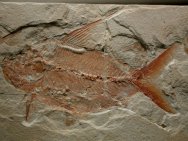Nematonotus longispinus
Class Actinopterygii, Infraclass Teleostei, Superorder Cyclosquamata, Order Aulopiformes
Geological Time: Middle Cretaceous, Cenomanian Stage (95 million years ago)
Size: 135 mm long
Fossil Site: Lebanese Lagerstatt, Hajoula, Lebanon
As a member of Infraclass Teleostei (one of the three infraclasses in class Actinopterygii), it is a ray-finned fish. The Teleostei comprises a diverse group that arose in the Triassic period, and has some 20,000 extant species in some 40 orders. By the end of the Cretaceous, teleost fish had come to dominant thre fishes in both marine and freshwater environments. The remaining two infraclasses of Class Actinopterygii, Holostei and Chondrostei, are paraphyletic. The fossil site near Hajoula, Lebanon where this fish came from is a remarkable Lagerstatt yielding an enormous diversity of exquisitely preserved fossils. The fishes are most notable, but invertebrates are also well represented. |






